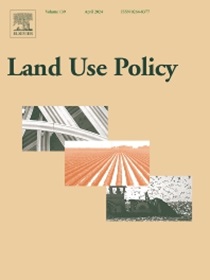2001年至2019年不同的全球土地变化情景
IF 5.9
1区 社会学
Q1 ENVIRONMENTAL STUDIES
引用次数: 0
摘要
全球土地利用和土地覆盖变化在环境变化、生物多样性保护、气候调节和生态系统服务等方面发挥着重要作用。在过去的几十年里,利用遥感或历史重建技术开发了MCD12Q1、ESA CCI-LC、GLC-FCS30D、HYDE 3.3、HILDA+ 、luh2等多个全球LULC数据集。在这项研究中,我们综合分析了六个全球LULC数据集之间的异同,揭示了2001 - 2019年土地覆盖的变化和转变。这一时期最显著的全球土地利用价值变化包括森林损失、耕地增加和聚落扩张。森林与耕地的相互转换尤为突出,约占所有土地利用转换的20% %。然而,在捕获全球LULC变化方面,各数据集之间存在显著差异。例如,森林净面积变化的估计值从增加1.10×105km2到减少1.55×106km2不等,而耕地面积变化的估计值从增加1.59×106km2到减少4.11×104km2不等。在GLC-FCS30D数据集中,定居点区域的增长最为显著。这些差异在非洲和南美洲的森林损失和耕地增加方面最为明显,而在亚洲的定居点扩张方面则最为明显。与FAOSTAT的比较表明,GLC-FCS30D和HYDE 3.3与耕地变化的拟合度较高,HILDA+与森林变化的拟合度较高。这些发现强调了协调LULC数据集对于提高全球土地变化评估的准确性和支持更好的环境管理战略的重要性。本文章由计算机程序翻译,如有差异,请以英文原文为准。
Divergent global land change scenarios from 2001 to 2019
Global land use and land cover (LULC) change plays a critical role in environmental change, biodiversity conservation, climate regulation, and ecosystem services. Over the past few decades, multiple global LULC datasets—such as MCD12Q1, ESA CCI-LC, GLC-FCS30D, HYDE 3.3, HILDA+ , and LUH2—have been developed using remote sensing or historical reconstruction. In this study, we comprehensively analyse the similarities and discrepancies among six global LULC datasets, revealing land-cover changes and transitions from 2001 to 2019. The most significant global LULC changes during this period include forest loss, cropland gain, and settlement expansion. The mutual conversion between forest and cropland was particularly prominent, accounting for around 20 % of all land-use transitions. However, notable discrepancies exist among the datasets in capturing global LULC changes. For example, estimates of net forest area change vary from an increase of to a decrease of , while cropland area changes vary from a rise of to a decline of . Settlement areas saw the most significant increase in the GLC-FCS30D dataset. These differences were most pronounced in Africa and South America for forest loss and cropland gain, and in Asia for settlement expansion. Comparisons with FAOSTAT show that GLC-FCS30D and HYDE 3.3 align closely with cropland changes, while HILDA+ closely matches forest change data. These findings highlight the importance of harmonizing LULC datasets to improve the accuracy of global land change assessments and support better environmental management strategies.
求助全文
通过发布文献求助,成功后即可免费获取论文全文。
去求助
来源期刊

Land Use Policy
ENVIRONMENTAL STUDIES-
CiteScore
13.70
自引率
8.50%
发文量
553
期刊介绍:
Land Use Policy is an international and interdisciplinary journal concerned with the social, economic, political, legal, physical and planning aspects of urban and rural land use.
Land Use Policy examines issues in geography, agriculture, forestry, irrigation, environmental conservation, housing, urban development and transport in both developed and developing countries through major refereed articles and shorter viewpoint pieces.
 求助内容:
求助内容: 应助结果提醒方式:
应助结果提醒方式:


